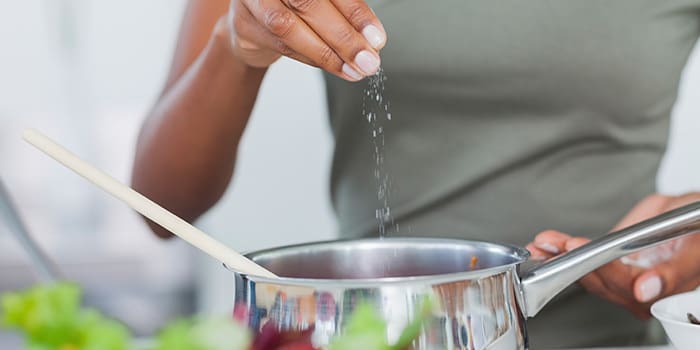Are You Eating Too Much Salt?

Are you eating too much salt? It’s likely that you are. 90% of Americans eat more salt than the recommended amount of 2,300 mg per day, about one teaspoon. In fact, Americans eat an average of 3,400 mg per day, a full 1,100 mg more than the U.S Dietary Guidelines recommend. People over 50 and those with high blood pressure, diabetes, or kidney disease should have even less sodium, or a maximum of 1,500 mg per day.
Salt makes food taste good, and a small amount is important in a healthy diet. But in excess, salt is linked to high blood pressure, a leading risk factor for heart disease, stroke, and other cardiovascular diseases.
WHAT YOU CAN DO
Read the Label
Most of the salt we eat comes from processed foods and restaurants. If you eat something that comes out of a bag, box, or can, read the nutrition information for sodium content. Chain restaurants are now required to provide the nutritional information about their menu items.
Pay Attention to Serving Size
Serving sizes can be deceiving, and very small! For example, a can of soup often contains 2 servings. If each serving has 650 mg of sodium and you eat the whole can, you’d have consumed more than half of your daily sodium in one meal!
Know Where Salt Lurks
Sodium goes by many different names. Read an ingredients list and you may see it called salt, sea salt, monosodium glutamate (MSG), sodium alginate, sodium citrate, sodium hydroxide, and sodium phosphate. Salt can also be hidden within other ingredients like yeast extract, natural flavor, malt extract, malt flavoring, natural beef or chicken flavoring, seasoning, spices and anything called “extract”, especially in savory foods. MSG is an ingredient in many additives including hydrolysed vegetable protein, hydrolysed protein, hydrolsyed plant protein, sodium caseinate, and calcium caseinate.
Choose “Low-Sodium” Foods
Look for the words “unsalted” or “low-sodium” on labels. These mean that the product has no salt or very little added salt. Avoid packaging that says “reduced-sodium.” This means that there is 25% less sodium than the original version, which is usually still too much. Just because something is low in salt doesn’t mean the product is good for you. Manufacturers often make up for the loss of flavor by adding sugar, fat, or additives.
Salt is Not Just an Ingredient in Junk Food!
Even pantry staples can be high in sodium. Check the sodium content of jarred pasta sauces, lunch meats, cheese, condiments, canned beans and vegetables, broths and soups.
Do you keep track of the amount of sodium you eat? Do you think you eat too much salt?
